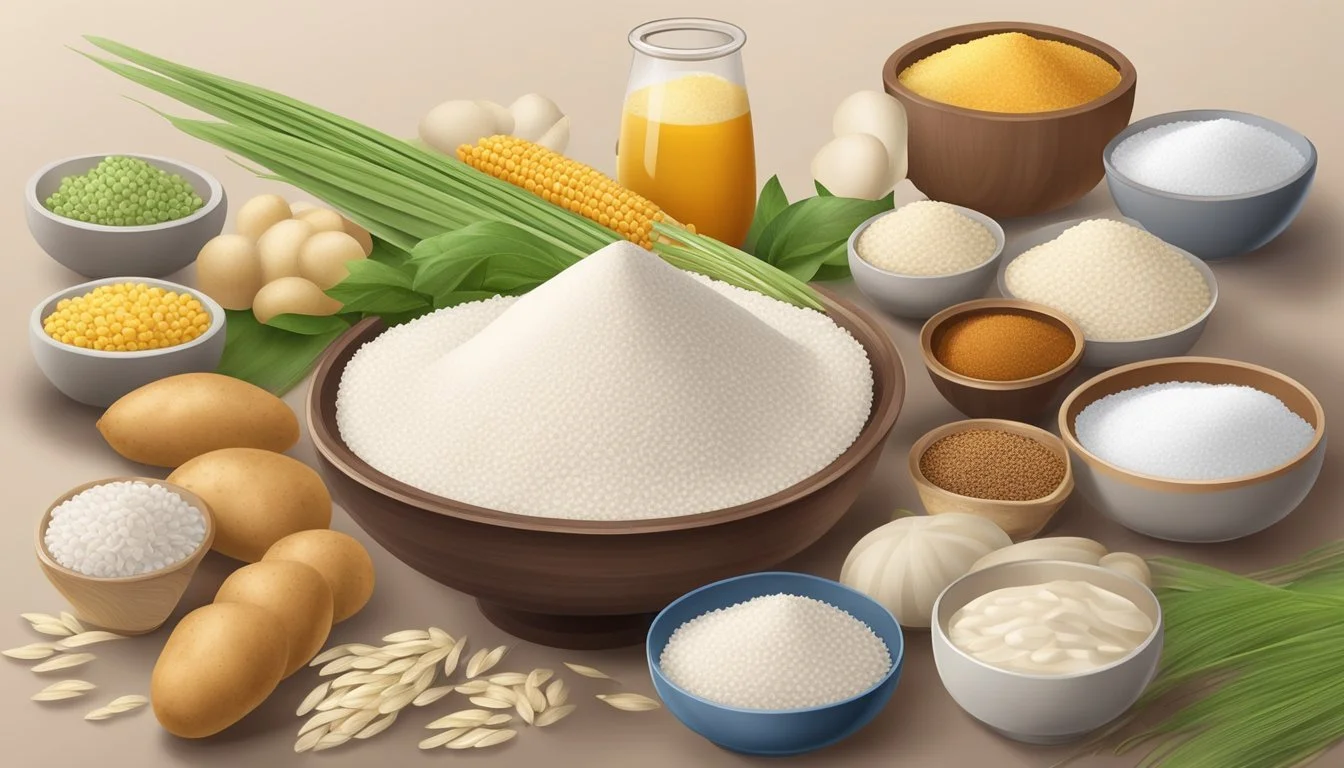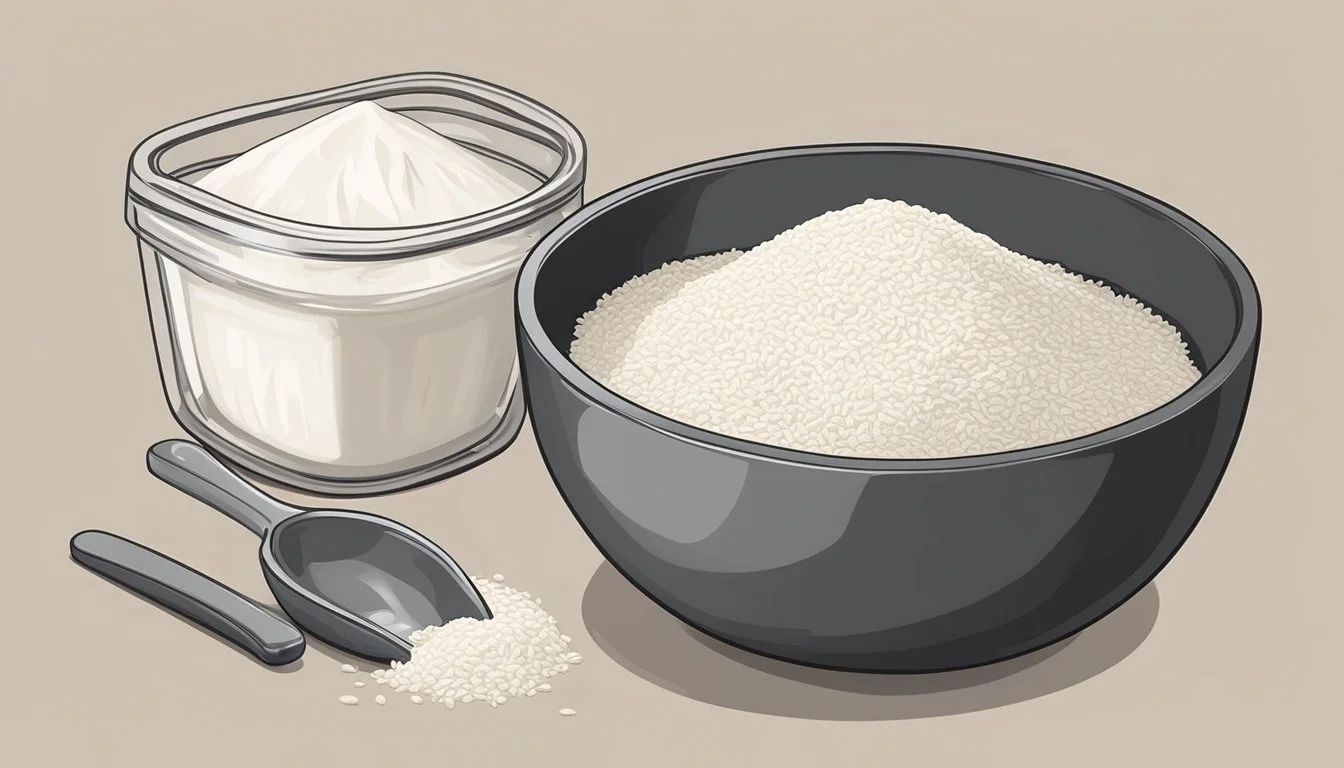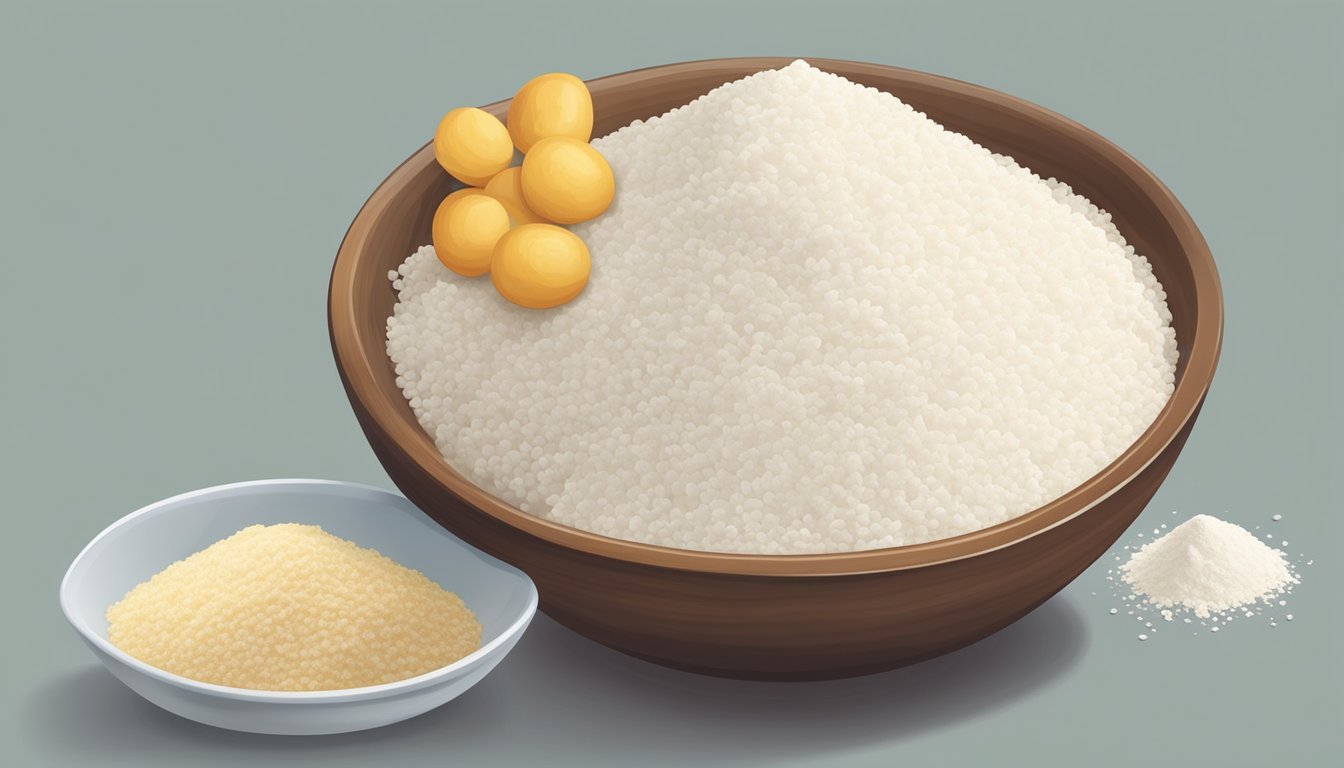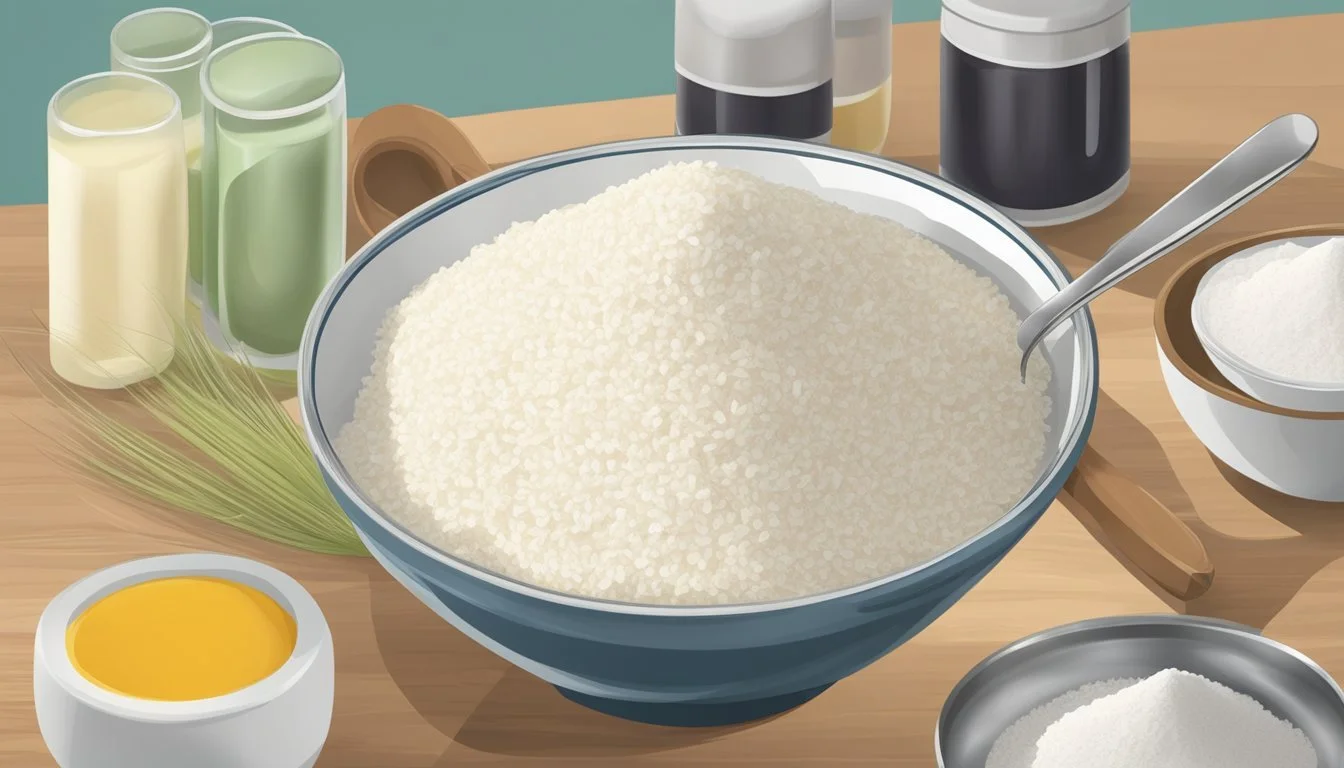Sweet Rice Flour Substitutes
Top Alternatives for Your Recipes
For those looking to replace sweet rice flour in their recipes, there are a variety of effective alternatives available. A common and reliable substitute is a gluten-free flour mix, which can be used in a 1:1 ratio, maintaining both flavor and texture in baked goods. Other good options include almond flour, tapioca starch, and sorghum flour, each with their own unique properties and substitution ratios.
When substituting, it’s important to adjust for different textures and consistencies. For instance, almond flour requires 1.5 cups for every cup of sweet rice flour, while a mix of brown rice flour and starches can provide a similar result with a different ratio. Cassava flour also serves as an excellent substitute due to its neutral flavor and gluten-free nature.
Experimenting with these alternatives ensures that dietary restrictions or ingredient shortages do not compromise the integrity of your recipes. Whether using tapioca starch for its chewiness or sorghum flour for a gluten-free option, these substitutes allow for flexibility and creativity in the kitchen.
Understanding Sweet Rice Flour
Sweet rice flour, also known as glutinous rice flour, is a versatile ingredient renowned for its sticky, chewy, and moist properties. It is especially prevalent in traditional Japanese desserts and other Asian cuisines, offering unique textures and flavors.
Characteristics and Uses
Sweet rice flour is milled from high-starch, short-grain glutinous rice. Despite being called "glutinous," it contains no gluten and is safe for gluten-free diets. The flour's high starch content makes it ideal for creating that characteristic sticky and chewy texture. This makes it a key ingredient in dishes such as mochi, a beloved Japanese dessert.
In addition to mochi, sweet rice flour is used to thicken sauces and soups, produce dumplings, and enhance the texture of various baked goods. It imparts a light, slightly nutty flavor that complements both sweet and savory recipes. The flour’s ability to retain moisture ensures that desserts like cakes and cookies remain soft and delightful.
Health and Nutritional Profile
Sweet rice flour is not only known for its culinary properties but also its nutritional benefits. It is a good source of carbohydrates, providing a quick energy boost. It contains small amounts of protein and essential micronutrients such as iron, magnesium, and vitamin B6.
However, it is low in fiber, so it might be beneficial to combine it with other higher-fiber flours in certain recipes. People with celiac disease or gluten intolerance can safely consume sweet rice flour, as it is naturally gluten-free. While it has a high glycemic index, moderation is key for those managing blood sugar levels.
In summary, sweet rice flour is a nutritious ingredient that enhances many traditional and modern recipes with its unique properties and flavors.
Substitute Criteria
When substituting sweet rice flour, the main factors to consider include the texture, flavor compatibility, and nutritional content of alternatives.
Texture Considerations
Sweet rice flour is known for its chewy and sticky texture, which is crucial in many recipes, especially desserts. Alternatives must mimic these properties closely. For example, gluten-free flour mix can be a 1:1 substitute, maintaining the integrity of the dish's texture.
Another option is cassava flour, which offers a similar viscosity and binds ingredients well. The combination of brown rice flour and starch like tapioca or cornstarch can also achieve a sticky texture. While sorghum flour provides less stickiness, combining it with another binding agent can help.
Flavor Compatibility
The flavor profile of sweet rice flour is neutral, so substitutes must not overpower the intended taste of the dish. Almond flour, with its mild nutty flavor, may require adjustments like additional sugar to blend seamlessly into sweet recipes.
Coconut flour can be used, but it has a distinct taste and requires 1.5 cups per cup of sweet rice flour due to its absorbency. Sorghum flour and cassava flour also offer neutral flavors, making them versatile in various recipes without altering the original taste.
Nutritional Considerations
Sweet rice flour is naturally gluten-free, which must be considered for those with dietary restrictions. Substitutes should ideally be gluten-free and nutritious, offering essential proteins, vitamins, and minerals.
Sorghum flour is rich in iron and other nutrients, making it a healthy alternative. Almond flour offers a good protein content and healthy fats, beneficial for those seeking nutritious options. Coconut flour also provides fiber, though it may require more liquid in recipes due to its absorbent nature.
Using a gluten-free flour mix ensures a balanced nutritional profile, often containing various flours that offer a range of vitamins and minerals. Cassava flour, although lower in protein, is another nutritious, gluten-free option.
Sweet Rice Flour Alternatives
When sweet rice flour is not available, various substitutes can mimic its unique properties. These alternatives can be categorized based on their gluten content, starchy texture, and nutrient enhancements.
Gluten-Free Substitutes
For those needing a gluten-free option, almond flour and sorghum flour provide excellent choices. Almond flour, made from finely ground almonds, offers a slightly nutty flavor and can replace sweet rice flour at a ratio of 1.5:1.
Sorghum flour, another gluten-free alternative, is suited for a variety of recipes. It provides a similar texture but requires careful measurement adjustments to ensure the correct consistency.
A gluten-free flour mix is often an all-in-one replacement. These mixes typically blend several flours like rice, potato starch, and tapioca starch, ensuring the right balance of flavor and texture. They can be used as a direct 1:1 substitute for sweet rice flour in most recipes.
Starchy Flour Substitutes
Tapioca starch and potato starch are star candidates for maintaining the chewy and sticky consistency that sweet rice flour provides. Tapioca starch is derived from cassava and can be used in equal amounts to sweet rice flour, making it perfect for dishes requiring a gooey texture.
Potato starch, extracted from crushed potatoes, offers similar benefits. Both starches can thicken sauces and improve the texture of baked goods without altering the flavor profile significantly.
Cornstarch is another viable substitute, known for its fine texture and thickening capabilities. Like tapioca and potato starch, cornstarch can be substituted in equal amounts. It is particularly useful in recipes where a slight increase in thickness is desired without adding extra flavor.
Nutrient-Enriched Substitutes
For those looking to add nutritional value, coconut flour and brown rice flour are excellent choices. Coconut flour, made from dried coconut meat, is rich in fiber and adds a subtle coconut flavor. It requires 1.5 times the quantity of sweet rice flour due to its absorbent nature.
Brown rice flour offers more nutrients compared to white rice flour and brings a slightly nutty taste. It can be used in similar quantities but may require additional liquid in the recipe to achieve the desired consistency.
Each substitute has unique properties that cater to different needs, making them versatile options in the absence of sweet rice flour.
Implementing Substitutes in Recipes
When substituting sweet rice flour in recipes, it's essential to choose the right alternative for the specific application, whether it be baking, cooking, or thickening. Each substitute affects the texture and flavor of the final product differently.
Baking with Substitutes
In baking, finding the perfect substitute for sweet rice flour is crucial to maintain the desired texture and consistency of baked goods. Tapioca flour and cornstarch are popular choices, often used in a 1:1 ratio, ensuring that the batter remains chewy and sticky. For gluten-free baking, cassava flour is an effective alternative, providing a neutral flavor and proper structure in breads and cakes. It is recommended to mix cassava flour with a small portion of another starch, like cornstarch, to improve the texture.
Almond flour can also be used but requires an adjustment in quantity, typically 1.5 cups of almond flour for every cup of sweet rice flour. This helps in creating a moist crumb structure, especially beneficial for muffins and brownies. Each of these substitutes can effectively replicate the essential properties of sweet rice flour, ensuring delicious baked goods.
Cooking with Substitutes
When it comes to cooking, especially in recipes requiring batters or coatings, choosing a suitable substitute for sweet rice flour can make a significant difference. Arrowroot flour is an excellent option, providing a light and crispy texture to fried items. The substitution ratio is typically 2 tablespoons of arrowroot flour for every 1 tablespoon of sweet rice flour, ensuring proper coating and crispness.
Sorghum flour is another viable alternative, offering a gluten-free solution with a slightly sweet flavor. It's perfect for thickening batters for frying or making gluten-free pancakes. Buckwheat flour brings a unique nutty flavor and is another effective substitute, providing a firm texture to cooked dishes.
By selecting the appropriate substitute, one can maintain the integrity and flavor profile of their cooking without compromising on texture or taste.
Thickening with Substitutes
For thickening sauces, gravies, and soups, the characteristics of the substitute play a pivotal role in achieving the right consistency. Tapioca starch is quite reliable, offering a similar starchy and sticky texture as sweet rice flour. It can be used in equal amounts and works well in both hot and cold liquids.
Cornstarch is another commonly used thickener, effective in creating a smooth and glossy finish in sauces. It should be mixed with a small amount of cold water before being added to the hot liquid to prevent clumping. Arrowroot flour also serves as a great alternative, particularly in acidic recipes where it maintains its thickening power.
Using these substitutes ensures that dishes requiring thickening agents achieve the desired consistency and texture.
Specific Sweet Rice Flour Substitutes
Several effective alternatives to sweet rice flour are available for various culinary needs. Each substitute brings its own unique properties, ensuring diverse textural and flavor outcomes.
Potato Starch as a Substitute
Potato starch is a versatile substitute for sweet rice flour. It is gluten-free and offers a similar sticky and thickening property, making it ideal for thickening soups, sauces, and even baking.
When substituting, use a 1:1 ratio as potato starch provides a similar consistency. This substitute is flavor-neutral and is effective in maintaining the desired texture in gluten-free recipes. Its high carbohydrate content also supports the chewy texture popular in desserts.
Tapioca Flour as a Substitute
Tapioca flour, derived from cassava root, is another gluten-free option. Noted for its neutral taste and excellent binding abilities, it can also be used in a 1:1 ratio with sweet rice flour.
This flour enhances the chewiness and flexibility of baked goods. Additionally, tapioca flour is suitable for thickening gravies and enhancing the texture of gluten-free breads and pastries. Its versatility makes it a valued substitute in many recipes.
Cornstarch as a Substitute
Cornstarch serves as an effective substitute for sweet rice flour in various culinary applications. Known for its high thickening power, it’s ideal for sauces, gravies, and pudding-like desserts.
Use a 1:1 ratio to maintain the desired consistency. Cornstarch is gluten-free and flavorless, ensuring it doesn't alter the taste of the final product. It also adds a glossy finish to sauces, making it a popular choice in the culinary world.
Other Flour Substitutes
There are several other flour substitutes worth considering:
White Rice Flour: Similar in texture but not as sticky; often combined with tapioca or cornstarch for better results.
All-Purpose Flour: Not gluten-free, but a viable substitute in non-gluten-free recipes.
Gluten-Free Flour Mix: These mixes usually contain a blend of flours and starches, including tapioca and potato starch, designed to replicate the properties of traditional flours.
Arrowroot Flour: Useful for thickening and baking, it provides a neutral taste and can often be used in a 1:1 ratio.
Each substitute offers different benefits, making it important to choose the one that best fits the specific needs of the recipe.
Adjustments for Substitutes
When substituting sweet rice flour, it is crucial to adjust for moisture balance and consistency to ensure the desired texture and flavor in your recipes. These adjustments vary based on the properties of the flour being used.
Moisture Balance
Different flours have varying moisture content, which can significantly affect the texture of your baked goods.
For instance, coconut flour tends to be highly absorbent. To compensate, it is often necessary to increase the liquid content in the recipe. Use a ratio of 1.5 cups of coconut flour for every cup of sweet rice flour and add extra liquid gradually until the desired batter consistency is achieved.
Almond flour also absorbs moisture but not as much as coconut flour. When using almond flour as a substitute, the general ratio is 1.5 cups of almond flour per cup of sweet rice flour. Additional liquid might not always be necessary but always check for a balanced, moist batter.
Tapioca starch requires less initial moisture adjustment. However, since it acts as a thickening agent, you might need to adjust other ingredients to avoid a gloopy texture. Begin with smaller amounts and add additional starch as required, ensuring smooth incorporation by whisking thoroughly.
Consistency and Binding
Ensuring the right consistency and binding properties is critical when using substitutes for sweet rice flour.
Coconut flour can make the mixture dry and crumbly. To counteract this, binding agents such as extra eggs or a tablespoon of chia seeds mixed with water can be incorporated. Coconut flour’s powdery nature requires vigorous whisking to avoid lumps.
Almond flour provides a similar texture to sweet rice flour. It helps maintain a moist and dense consistency, ideal for cakes and muffins. Using almond flour can also add a slight nutty flavor which complements many recipes. When aiming for a lighter texture, consider sifting the almond flour to break up any clumps.
Sorghum flour often needs additional binders such as xanthan gum or psyllium husk. These help achieve the chewy texture desired in gluten-free recipes. The typical recommendation is to use about a teaspoon of binder per cup of sorghum flour, ensuring thorough mixing to avoid a gritty texture.
These adjustments will help achieve the desired outcome, whether in bread, muffins, or other baked dishes.
Alternative Applications
Sweet rice flour, also known as mochiko flour, serves various culinary needs beyond its primary uses. It finds application in both savory and sweet dishes, and is a staple in many Asian cuisines.
Savory Dish Application
Sweet rice flour can enhance the texture of many savory dishes. It serves as an excellent thickening agent for soups, stews, and sauces. This flour blends smoothly, providing a glossy finish without altering the flavor profile.
Pancakes and rice cakes can also incorporate sweet rice flour for a chewy texture. It is often used in health food recipes where gluten-free or low-carb ingredients are desirable. Battered items such as tempura benefit from sweet rice flour's ability to create a crisp, light coating.
Sweet Dish Application
In sweet dishes, sweet rice flour is a versatile ingredient. Its sticky and chewy texture makes it popular in various desserts, particularly those requiring a certain resilience like cakes and mochi.
One can use it in gluten-free baking recipes, where its high starch content ensures structural integrity. Adding it to pancake or muffin batter can yield a softer and moist product. Rice noodles made with sweet rice flour provide a delightful chewiness, ideal for cold desserts or sweet broths.
Asian Cuisine Application
Sweet rice flour is a cornerstone in Asian cuisines. It is essential in making traditional Japanese mochi, a sticky rice cake enjoyed during celebrations. In Chinese cuisine, it is used to make dumpling wrappers and various festival sweets.
Additionally, this flour is crucial in Korean cuisine, specifically in recipes like tteokguk (rice cake soup) and sikhye (sweet rice drink). Savory and sweet dishes alike benefit from its unique properties, allowing chefs to create dishes with authentic texture and flavor.
Sweet rice flour’s role in Asian cuisine illustrates its adaptability, moving seamlessly from rice noodles to desserts. Its contributions to cultural dishes highlight its value in maintaining traditional recipes while offering a gluten-free alternative for modern cooks.
Substitution Ratios and Tips
When swapping sweet rice flour in recipes, accurate substitution ratios are essential to maintain texture and flavor. Below are some common substitutes and their recommended ratios.
Coconut Flour: Use 1.5 cups of coconut flour for every 1 cup of sweet rice flour. This is ideal for cakes and muffins due to its moisture-absorbing properties.
Almond Flour: Substitute with a 1.5:1 ratio. For example, 1.5 cups of almond flour can replace 1 cup of sweet rice flour in recipes such as pancakes and breads.
Sorghum Flour: Use an equal amount of sorghum flour as sweet rice flour. This 1:1 replacement works well in batters for rice noodles and cakes.
Brown Rice Flour Mix: Combine 2/3 cup of brown rice flour with 1/3 cup of tapioca or cornstarch to replace 1 cup of sweet rice flour. This blend is suitable for recipes like pancakes and muffins.
Gluten-Free Flour Mix: A standard gluten-free flour mix can substitute sweet rice flour on a 1:1 basis. This makes it a reliable choice for most baked goods, including cakes and breads.
Tips
Moisture Content: Some substitutes, like coconut and almond flour, absorb more moisture. Adjust liquid ingredients in recipes to prevent dryness.
Binding Agents: If a substitute lacks the stickiness of sweet rice flour, add a small amount of xanthan gum or guar gum (about 1/4 teaspoon per cup of flour).
Texture: For batters and doughs requiring a chewy texture, such as rice noodles, ensure the substitute has adequate starch content.
Employ these ratios and tips to successfully use sweet rice flour substitutes in various recipes.







